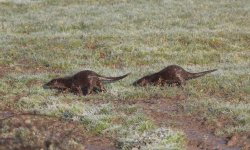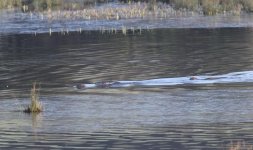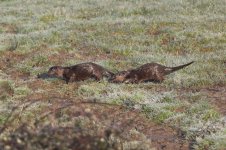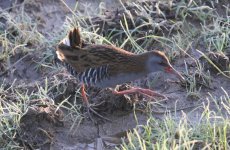-
Welcome to BirdForum, the internet's largest birding community with thousands of members from all over the world. The forums are dedicated to wild birds, birding, binoculars and equipment and all that goes with it.
Please register for an account to take part in the discussions in the forum, post your pictures in the gallery and more.
You are using an out of date browser. It may not display this or other websites correctly.
You should upgrade or use an alternative browser.
You should upgrade or use an alternative browser.
Camel Estuary, Cornwall (1 Viewer)
- Thread starter camelbirder
- Start date
More options
Who Replied?Max Shearwater
Well-known member
Great to see Colin, the last time I saw otters there were 3 of them and they came in from the stream behind the hides. Always memorable moments and the photos are a bonus!
Three Otter this morning at Amble Marshes, female plus two full grown young, plus 2 Water Rail.
Great to see Colin, the last time I saw otters there were 3 of them and they came in from the stream behind the hides. Always memorable moments and the photos are a bonus!
I agree, it's always a privilege to see them, partly as you can never predict when or where they are likely to appear. This time they came in from the direction of Amble.
Max Shearwater
Well-known member
Coots building a nest at Walmsley and 3 pairs of little Grebe getting very territorial.
2 male and 2 female goosander at Guineaport first thing this morning swimming up river. Blue tits busy inspecting the bird box and great to hear so many birds starting to sing in the morning - role on Spring!
Birds at Walmsley today included Water Rail (click for video), 26 Lapwing, 50+ Black Headed Gull (including one in full Summer plumage), Herring Gull, Great Blacked Backed Gull, Lesser Black Backed Gull, Curlew, Wigeon, Teal, 3 Grey Heron, 3 Little Egret, 12 Gadwall, Coot, Moorhen, Shelduck, 2 Black Tailed Godwit, 6 Tufted Duck, Shoveler
Last edited:
Dave Parker
Well-known member
Terek Sandpiper at Walmsley Sanctuary
Adrian Langdon, the CBWPS Warden for the reserve has commented on access for tomorrow as follows:
"I’ll open the hide at 06:30 and ask for it to be left open for the day.
I’ve arranged parking for a voluntary donation of £2 in the field by the bridge. It has an advertising banner on the gate for “storage facilities” on the gate and we are asked to park to the right on higher ground to avoid getting stuck and tearing up the field!"
Thanks Adrian.
Good luck if you go and please follow any on site instructions.
Dave
Adrian Langdon, the CBWPS Warden for the reserve has commented on access for tomorrow as follows:
"I’ll open the hide at 06:30 and ask for it to be left open for the day.
I’ve arranged parking for a voluntary donation of £2 in the field by the bridge. It has an advertising banner on the gate for “storage facilities” on the gate and we are asked to park to the right on higher ground to avoid getting stuck and tearing up the field!"
Thanks Adrian.
Good luck if you go and please follow any on site instructions.
Dave
Cornish Chough
Well-known member
Adrian Langdon, the CBWPS Warden for the reserve has commented on access for tomorrow as follows:
"I’ll open the hide at 06:30 and ask for it to be left open for the day.
I’ve arranged parking for a voluntary donation of £2 in the field by the bridge. It has an advertising banner on the gate for “storage facilities” on the gate and we are asked to park to the right on higher ground to avoid getting stuck and tearing up the field!"
Thanks Adrian.
Good luck if you go and please follow any on site instructions.
Dave
Looks like a one day wonder.
camelbirder
Well-known member
The Camel Estuary Wildlife Website is up and running with all the wildlife sightings from the area.
camelbirder
Well-known member
Very little bird news today but a Mammal fest on the sea off Rumps Point see Camel Estuary Website
Kernow Pete
Kernow Pete
NEWS – Non-Estuarine Waterbird Survey.
This winter the BTO will be running the third Non-Estuarine Water bird Survey (NEWS). This periodic survey focuses on the non-estuarine shoreline, which is not so well covered by the Wetland Bird Survey (WeBS). These rocky shores, along which extensive beds of seaweed may be exposed at low tide, or sandy beaches with extensive strandlines, can support substantial invertebrate populations. These are favoured habitats for a number of waders over-wintering in the UK. The Purple Sandpiper and the majority of overwintering Turnstone occur in this habitat, while substantial proportions (between 10% and 50%) of Ringed Plover, Sanderling, Curlew, Oystercatcher and Redshank also overwinter along the open coast.
If you are interested in contributing to this important survey all that is required is that you commit to visit one or more count stretches, each on a single occasion, over the low-tide period, on a day of your choice, between 1st December and 31st January. This will involve walking a stretch of coast and recording the birds you encounter as you go. Count stretches are typically 2km long, some a bit shorter, some a bit longer. It is essential that all waders and waterbirds using the intertidal zone are recorded, but we would hope that most volunteers would also count all waterbirds on the sea to a distance where they would be visible to the naked eye, and all those using landward habitat immediately adjacent to the shore. As well as recording birds, we also ask you to record mammals and information on the strandline. Additional visits are also welcomed. You can select a stretch for surveying online at http://www.bto.org/webs-news and find out more information about the survey.
This winter the BTO will be running the third Non-Estuarine Water bird Survey (NEWS). This periodic survey focuses on the non-estuarine shoreline, which is not so well covered by the Wetland Bird Survey (WeBS). These rocky shores, along which extensive beds of seaweed may be exposed at low tide, or sandy beaches with extensive strandlines, can support substantial invertebrate populations. These are favoured habitats for a number of waders over-wintering in the UK. The Purple Sandpiper and the majority of overwintering Turnstone occur in this habitat, while substantial proportions (between 10% and 50%) of Ringed Plover, Sanderling, Curlew, Oystercatcher and Redshank also overwinter along the open coast.
If you are interested in contributing to this important survey all that is required is that you commit to visit one or more count stretches, each on a single occasion, over the low-tide period, on a day of your choice, between 1st December and 31st January. This will involve walking a stretch of coast and recording the birds you encounter as you go. Count stretches are typically 2km long, some a bit shorter, some a bit longer. It is essential that all waders and waterbirds using the intertidal zone are recorded, but we would hope that most volunteers would also count all waterbirds on the sea to a distance where they would be visible to the naked eye, and all those using landward habitat immediately adjacent to the shore. As well as recording birds, we also ask you to record mammals and information on the strandline. Additional visits are also welcomed. You can select a stretch for surveying online at http://www.bto.org/webs-news and find out more information about the survey.
camelbirder
Well-known member
camelbirder
Well-known member
An unusual pipit was located at Treraven Meadows today, photograph available here. Very little other news received.
The Rumps
Hi guys,
Merry Christmas!
Spent a couple of hours up The Rumps today near Polzeath.
Lots to see:
2 pairs of Stonechat
Numerous Gannets, Fulmars, Gulls (Herring and Great BB)
Several Guillemots and Razorbills.
6 or so Rock Pipits.
4/5 Grey Seals
3/4 Harbour Porpoise
The highlight was a Black Redstart, very mobile but good views on Rumps Point itself.
All the best, Edward.
Hi guys,
Merry Christmas!
Spent a couple of hours up The Rumps today near Polzeath.
Lots to see:
2 pairs of Stonechat
Numerous Gannets, Fulmars, Gulls (Herring and Great BB)
Several Guillemots and Razorbills.
6 or so Rock Pipits.
4/5 Grey Seals
3/4 Harbour Porpoise
The highlight was a Black Redstart, very mobile but good views on Rumps Point itself.
All the best, Edward.
Users who are viewing this thread
Total: 2 (members: 0, guests: 2)







